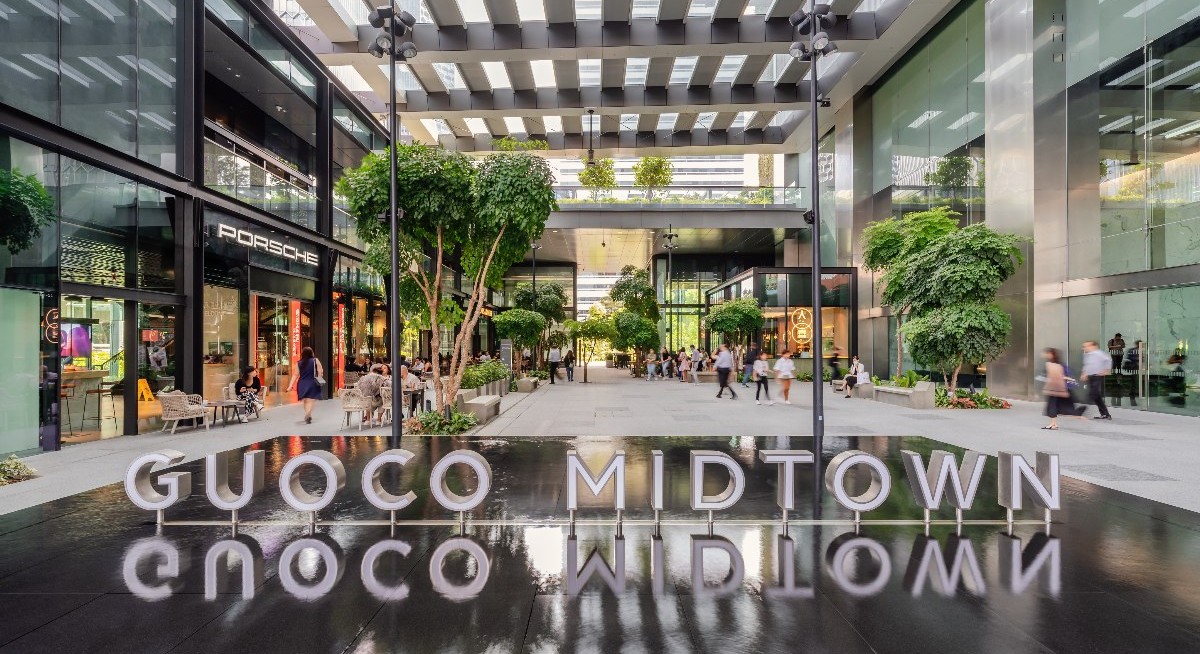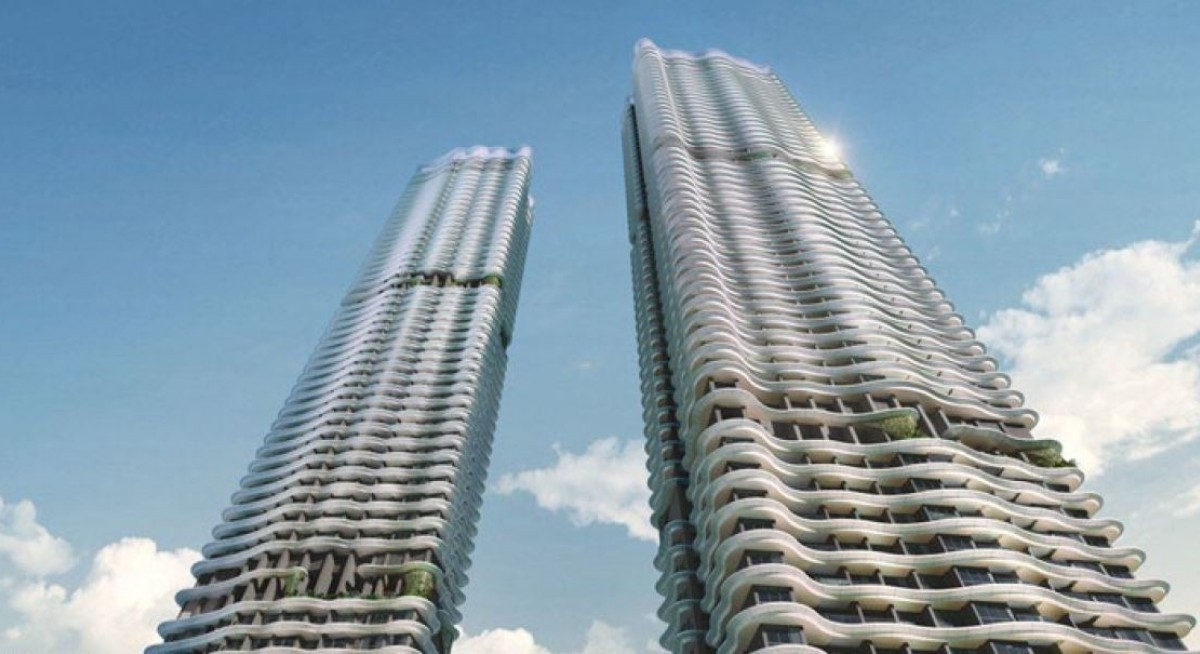F17’s full-year revenue stood 18% higher y-o-y than the $1.54 billion logged in FY2023.
Both the group’s “twin engines” of property development and property investment notched strong growth y-o-y. In FY2024, property development revenue grew 16% y-o-y to $1.52 billion, still representing the larger share of the group’s revenue; while property investment revenue grew 35% y-o-y to $229 million.
See also: PropNex soars, capturing greater market share amid challenging real estate climate
See also: Shaping the future of sustainable mobility
 Since Guoco Tower commenced commercial operations in FY2017, rental revenue has grown from $70 million to $229 million today, representing a compound annual growth rate of 18% over the last eight years. Photo: GuocoLand
Twin engines
GuocoLand’s property development engine has served the group well over the last three decades and continues to generate good development profits, says Cheng. “In the last decade, we have also built strong capabilities and a good reputation for developing high-quality mixed developments with Grade A offices that form our property investment portfolio.”
To build property investment as a second growth engine, the group acquired the Guoco Tower site in Tanjong Pagar in 2010. In 2017, the group expanded into the Beach Road-Bugis district with the acquisition of the Guoco Midtown site. “The rental generated from these integrated mixed developments, as well as 20 Collyer Quay, now provides a steady stream of recurring income,” says Cheng.
Since Guoco Tower commenced commercial operations in FY2017, rental revenue has grown from $70 million to $229 million today, representing a compound annual growth rate of 18% over the last seven years. “Looking ahead, we expect this recurring income to continue growing when Guoco Midtown II comes onstream in FY2025, and [when] Lentor Modern’s retail mall [opens] in FY2026,” Cheng adds.
GuocoLand has doubled the asset value of its investment properties from $3.05 billion in FY2017 to $6.56 billion in FY2024. “The unique value proposition of our buildings has resulted in overall high occupancy rates, positive rental reversions and premium rental rates,” says Cheng.
‘Adjustments’ in overseas markets
Outside of Singapore, Cheng notes that the property markets in China and Malaysia are undergoing “significant adjustments”.
Currently, GuocoLand’s sole commercial property in China is Guoco Changfeng City, a large-scale mixed development in Shanghai comprising two 18-storey Grade A office towers and a basement retail mall. GuocoLand also has two ongoing residential developments in China: Guoco 18T and Guoco Central Park, both located in Chongqing.
“China is the second-largest economy in the world with a strong domestic corporate and manufacturing base, and a vast domestic market that can drive consumption demand,” says Cheng. “Amidst China’s uncertain property market, we are actively monetising our assets in China. Even as we do that, we are watching the market closely for suitable opportunities in the Tier 1 cities we are in, namely Shanghai and Chongqing.”
Cheng’s rationale is that large corporations and professional talent will “continue to gravitate” towards these cities as they provide more developed infrastructure, markets and networks.
Closer to home, GuocoLand’s indirect subsidiary Guocoland (Malaysia) Berhad (GLM) has developed the integrated mixed development Damansara City in Kuala Lumpur, comprising two Grade A office towers, a serviced apartment tower, a luxury hotel and a retail mall.
GLM, which is separately listed in Malaysia, is also developing Emerald 9, an integrated mixed development at Batu 9, Cheras.
“We believe that Malaysia will benefit from the current geopolitical environment, in which supply chains are seeking to set up manufacturing bases there. With this in mind, we are exploring the possibility of repositioning our landbank in Malaysia into industrial townships,” says Cheng.
Since Guoco Tower commenced commercial operations in FY2017, rental revenue has grown from $70 million to $229 million today, representing a compound annual growth rate of 18% over the last eight years. Photo: GuocoLand
Twin engines
GuocoLand’s property development engine has served the group well over the last three decades and continues to generate good development profits, says Cheng. “In the last decade, we have also built strong capabilities and a good reputation for developing high-quality mixed developments with Grade A offices that form our property investment portfolio.”
To build property investment as a second growth engine, the group acquired the Guoco Tower site in Tanjong Pagar in 2010. In 2017, the group expanded into the Beach Road-Bugis district with the acquisition of the Guoco Midtown site. “The rental generated from these integrated mixed developments, as well as 20 Collyer Quay, now provides a steady stream of recurring income,” says Cheng.
Since Guoco Tower commenced commercial operations in FY2017, rental revenue has grown from $70 million to $229 million today, representing a compound annual growth rate of 18% over the last seven years. “Looking ahead, we expect this recurring income to continue growing when Guoco Midtown II comes onstream in FY2025, and [when] Lentor Modern’s retail mall [opens] in FY2026,” Cheng adds.
GuocoLand has doubled the asset value of its investment properties from $3.05 billion in FY2017 to $6.56 billion in FY2024. “The unique value proposition of our buildings has resulted in overall high occupancy rates, positive rental reversions and premium rental rates,” says Cheng.
‘Adjustments’ in overseas markets
Outside of Singapore, Cheng notes that the property markets in China and Malaysia are undergoing “significant adjustments”.
Currently, GuocoLand’s sole commercial property in China is Guoco Changfeng City, a large-scale mixed development in Shanghai comprising two 18-storey Grade A office towers and a basement retail mall. GuocoLand also has two ongoing residential developments in China: Guoco 18T and Guoco Central Park, both located in Chongqing.
“China is the second-largest economy in the world with a strong domestic corporate and manufacturing base, and a vast domestic market that can drive consumption demand,” says Cheng. “Amidst China’s uncertain property market, we are actively monetising our assets in China. Even as we do that, we are watching the market closely for suitable opportunities in the Tier 1 cities we are in, namely Shanghai and Chongqing.”
Cheng’s rationale is that large corporations and professional talent will “continue to gravitate” towards these cities as they provide more developed infrastructure, markets and networks.
Closer to home, GuocoLand’s indirect subsidiary Guocoland (Malaysia) Berhad (GLM) has developed the integrated mixed development Damansara City in Kuala Lumpur, comprising two Grade A office towers, a serviced apartment tower, a luxury hotel and a retail mall.
GLM, which is separately listed in Malaysia, is also developing Emerald 9, an integrated mixed development at Batu 9, Cheras.
“We believe that Malaysia will benefit from the current geopolitical environment, in which supply chains are seeking to set up manufacturing bases there. With this in mind, we are exploring the possibility of repositioning our landbank in Malaysia into industrial townships,” says Cheng.








.jpg)

